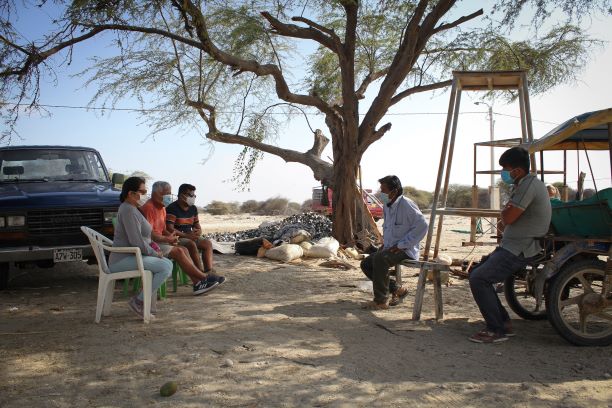Sechura is located on the north coast of Peru, in the region of Piura. It has an area of 6311.69 km2 and an average altitude of 15 meters above sea level. It is divided into six districts, which are: Sechura (Capital of the Province), Bellavista de La Unión, Bernal, Cristo Nos Valga, Rinconada de LLicuar and Vice (INEI, 2017).

Sechura is the home of the widest area of desert in coastal Peru. Communities that are located on the coast dedicate most of their activity to artisanal fishing in the sea. Despite being an area with a fairly hot climate and with lack of water, there are also communities further inland that develop activities such as agriculture, livestock, continental fishing, beekeeping, among others.
When we started our work on this research project, we were very excited to be able to travel to Sechura and learn about the experiences of local people in relation to their economic activities. However, we received the bad news of the arrival of COVID-19 in Peru and with it, our government imposed certain restrictive regulations that stopped a large part of the activities that we had programmed. Despite this, we adapted to the situation and reconsidered our work plan. At first we were able to analyze information available on the web, reports, theses, etc., which allowed us to better know these communities. Likewise, through telephone calls we were able to interview and make the first contacts with the inhabitants of the desert, thanks to the database provided by the NGO Prisma. Thus, we learned more about the communities that live in the desert and the level of impact that climate change and the El Niño phenomenon had on them. Through these experiences, we were able to identify some populated centers in the districts of Cristo Nos Valga and Bernal, due to their proximity to the “Ñapique”, “Ramón” and “La Niña” lagoons.
A few months later, the restrictions in Peru changed. With great caution and under a strict biosafety protocol, we were able to visit some populated centers in the desert. Among them are the most populated such as “Chutuque” and “Mala Vida” whose population is around 250 to 300 families. Around it there are also other populated centers such as “Nuevo Pozo Oscuro”, “Los Jardines”, “La Algarrobera”, among others. Families in this desert area have many economic deficiencies and basic services. They have limited access to water for family use, electricity is limited (only in some populated centers), and similarly the urban and telecommunications infrastructure is almost non-existant. Despite this, we were able to observe many children who take advantage of the tranquility of the desert to play.

The use of water for agriculture is very limited, therefore agriculture is normally carried out in small areas (<1 hectare) with little technology. The residents eagerly await the rainy season that begins in the summer (January to March); consequently, these rains moisten the soils and are suitable for growing food for a short vegetative period. In addition, these rains increase the water level in the Rivers and some lands may have temporary access to water, which is irrigated with the help of hydraulic pumps. Thus, the inhabitants of these desert communities can plant products in a limited way, such as: corn, sweet potato, various varieties of beans, watermelon, melon, cotton, squash, etc. These will then be harvested and commercialized, however much of it is stored for family consumption during the other seasons of the year.


Lately however, we have been visiting some populated centers in Sechura that are located near the channel of the Piura river. We have been interviewing residents of populated centers such as “San Cristo”, “Cerritos”, “Onza de Oro”, and unlike desert settlers, most families have irrigation canals in their agricultural fields. It has allowed them to develop a diversified agriculture such as cotton, rice, varieties of beans, sweet potatoes, fruit trees, squash, watermelon, etc. In addition, they have been able to develop raising animals such as goats, sheep, pigs, chickens in greater abundance than the desert populations.

The fishing is an important activity for these inhabitants; however, a large part of the fishermen are fishing in the sea and some take advantage of the Ñapique lagoon and other areas to catch mullet (Mugil cephalus) or tilapia (Oreochromis niloticus).
With the presence of extreme events such as “The El Niño phenomenon”, two situations are contrasted, in the desert area this event is seen by the inhabitants as a “blessing” since the abundance of water improves their agriculture, livestock and fishing. However, the residents of the lower zone mention that it has a negative impact on them, in most of their economic activities.
We hope that the information we have been collecting will allow us to better understand this difference and propose ideas so that the local government, private companies and NGOs are interested in contributing knowledge, development plans and technology to improve the quality of life of these families.


This blog was writed by: Ivan Gomez (1) , Evelyn Inguil (2), Maya Gomez-Coultas(3) and Gabriel Bonnamy (3)
(1),(2), La Molina National Agrarian University – Perú, Lima / (3) St. Andrews University- -UK, Scotland



